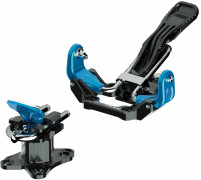Atomic Backland UL 65 2.0 Ski
Naming note: according to Atomic’s ski-naming department, this ski is still the Backland UL 65. As far as the ski and its performance characteristics are concerned, however, this is a very different ski than the original in all the best ways. In order to minimize and/or increase confusion, we are calling the 2018/19+ edition the 2.0. Now that that’s out of the way, let’s get on to the ski.
The original Backland UL 65 has been a hit amongst the race community, favored for its durability and versatility. Atomic decided to tweak a few things which resulted in a ski that’s more energetic, powerful, and comfortable at speed but just as fun and easy to manage. The turn radius and effective edge have been increased to improve stability at speed so you can feel even more comfortable keeping them pointed down the fall line. The longer effective edge promotes excellent grip and control. In order to counteract the “cruise-missile” effect that comes with long turn-radii, an extra dose of camber was added. This allows for fun, energetic carves of varying shape. The added camber also gives a bit of extra pop while skinning, a.k.a. “free speed”.
The HRZN Tech tips are a novel design that came from Atomic’s freeride skis. The red sections on the tip of the ski are rockered perpendicular to the ski (think of a boat hull) to add extra flotation without adding mass. This improves the UL 65’s already-stellar soft snow performance and allows for more aggressive positioning on the ski. The tails have been tapered to speed-up transitions by guiding the skis into a pack loop and also help the ski release from turns. So, go ahead and point ‘em. They’ll do the rest.
- HRZN Tech Tip adds extra flotation and helps in challenging snow conditions.
- Sloped topsheet minimizes snow accumulation, ensuring that your light skis stay light.
- Fiber Grid layer built into the topsheet adds durability and stability.
Update 2020/21: Old reliable stays mostly the same, albeit with an updated paint job.
Update 2022/23: Same ol' ski with updated topsheet graphics.
Update 2024/25: Same reliable ski, different topsheet.
Update 2025/26: Same ski with a new graphic and an additional 151cm length.
| Specifications | |
| Length(s) cm | 151, 161 |
|
Weight |
698g [161] |
| Weight (pair) | 1396g [161] |
|
|
93-65-78.5 [161] |
|
Turn |
24m [161] |
|
Skin |
Tip notch |
| Specs Verified | 161 Only |
| Design | |
|
|
HRZN Tech Tip, camber, semi-rockered tail |
|
|
Hook-free HRZN Tech tip, long radius, tapered tail |
|
|
Cap w/ carbon laminates |
|
|
Karuba + Poplar |
| Skimo Co Says | |
| Usage | Skimo racing, speed touring, training |
| Notes | Longer running edge and more camber than previous model |
| Bottom Line | Skimo race ski made for the modern skimo racer |
| Compare to other Race Skis | |
Related Products
Questions & Reviews
Cheers
Regardless of whether I'm skiing resort laps, backcountry pow, or spring corn, they always feel like the right ski for the job with a few adjustments to technique depending on conditions and as long as your priority firmly remains racking up vert and distance.
More than once I encountered folks in the backcountry who were astounded to see how well these sticks handled deep snow; however, I do still get the most enjoyment out of skiing them on-piste or in relatively simple spring conditions, and will only break them out for deep days if I have a lot of distance to cover, a speed objective, or for the sheer novelty.
Obstacles like breakable crust, while not fun to encounter on any ski, become objectively worse on skis as light and narrow as the backland 65, and so when encountering mixed snow conditions is likely, I prefer the backland 78 or 85 UL.
In fairly straightforward conditions, skiing the 65 is a sheer joy, as they are incredibly playful, poppy, and confidence-inspiring. They are also highly durable for their weight, which is so light that they're also ideal for multi-sport outings, such as running or cycling with them attached to your pack on the way to the trailhead.
TIA!
Great question, the Dynafit Superlite 150 can indeed be mounted on this ski!
The reshaping of the tip and tail, along with the lessened tip rocker amount will change its performance for sure. The shorter rocker will increase the running edge and the tip shape will help with stability and limit deflection. The new tail shape should help the ski release from turns a little easier, especially in tough conditions.
Depending on how you are using the word aggressive, the answer is "possibly."
I'm realizing we may be a bit late to the party answering your initial question, but perhaps others will be interested in this same comparison in the future! :-)
Earn store credit by writing reviews. Learn more.

















